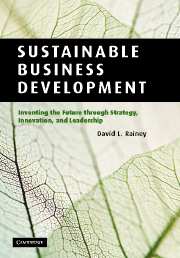Book contents
- Frontmatter
- Contents
- List of figures
- List of tables
- List of boxes
- List of abbreviations
- Acknowledgments
- Introduction
- Part I Enterprise thinking, the driving forces of change, and leadership
- Part II Innovation management, life cycle considerations, and insights
- 7 Sustainable technology management and development
- 8 Crafting and implementing sustainable business development programs
- 9 Life cycle thinking and framework
- 10 Formulation of life cycle assessment: initiation and inventory assessment
- 11 Implementation of life cycle assessment: impact and improvement assessments
- 12 Inventing the future through enterprise thinking and sustainable business development
- Glossary
- Select bibliography
- Index
- References
11 - Implementation of life cycle assessment: impact and improvement assessments
from Part II - Innovation management, life cycle considerations, and insights
Published online by Cambridge University Press: 04 December 2009
- Frontmatter
- Contents
- List of figures
- List of tables
- List of boxes
- List of abbreviations
- Acknowledgments
- Introduction
- Part I Enterprise thinking, the driving forces of change, and leadership
- Part II Innovation management, life cycle considerations, and insights
- 7 Sustainable technology management and development
- 8 Crafting and implementing sustainable business development programs
- 9 Life cycle thinking and framework
- 10 Formulation of life cycle assessment: initiation and inventory assessment
- 11 Implementation of life cycle assessment: impact and improvement assessments
- 12 Inventing the future through enterprise thinking and sustainable business development
- Glossary
- Select bibliography
- Index
- References
Summary
Introduction
The implementation phases of LCA include impact assessment and improvement assessment. These phases transform information and data organized during the inventory phase into meaningful and valuable analyses and actions. These phases of LCA can touch all the life cycle stages of a product or process, putting SBD principles into action on the broadest scale. Implementation involves intensive activities aimed at improving the value proposition (economics), enhancing the viability of products and processes (social), and mitigating the consequences and impacts (environmental).
As discussed previously, impact assessment transforms the inventory assessment into a comprehensive awareness of the strengths and weaknesses of the product architecture and the process structures that can then reveal improvement opportunities. It explores processes and subprocesses to verify that decisions are appropriate and in line with the corporate objectives and the expectations of constituents.
Improvement assessment then translates the identified opportunities into realities. It is the least definitive of the phases since it depends on context. Improvements may include proving that everything meets specifications, enhancing existing positive attributes, reducing defects and burdens, mitigating impacts, and ensuring longevity. It is impossible to spell out all the possible scenarios.
This chapter focuses on major risk-reduction methods involved in implementing LCA. Despite the ever-present potential for hidden defects, management must strive to ensure that products and processes are safe, appropriate, effective, and meet the expectations of all constituencies. The logic-based precautionary principle suggests that LCA is a necessary means to achieve the “triple bottom line,” as the corporation moves toward SBD.
Information
- Type
- Chapter
- Information
- Sustainable Business DevelopmentInventing the Future Through Strategy, Innovation, and Leadership, pp. 606 - 646Publisher: Cambridge University PressPrint publication year: 2006
